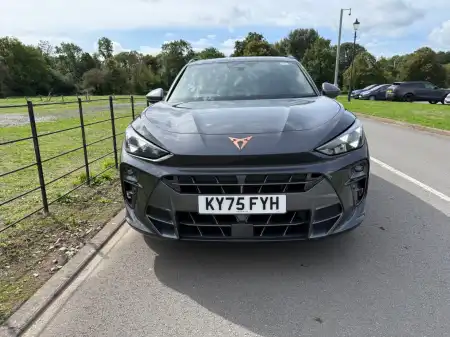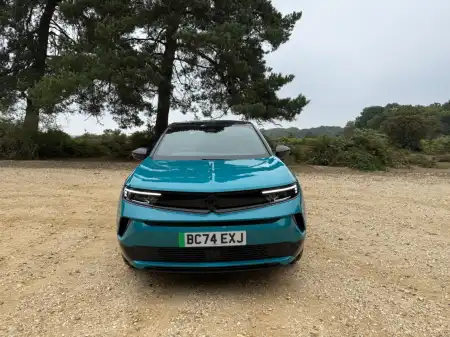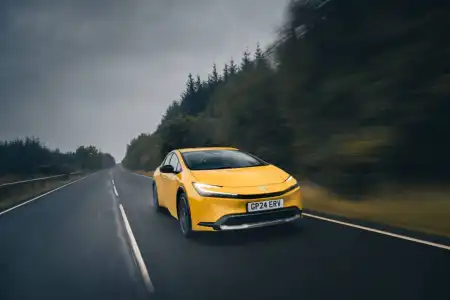- Well balanced with smooth ride quality
- Competitively priced
- Choice of powertrains and well-equipped trims
- Rear-hinged back doors are totally unpractical
- Fuel efficiency drops rapidly on a motorway
- Over-the-shoulder visibility is poor
Introduction
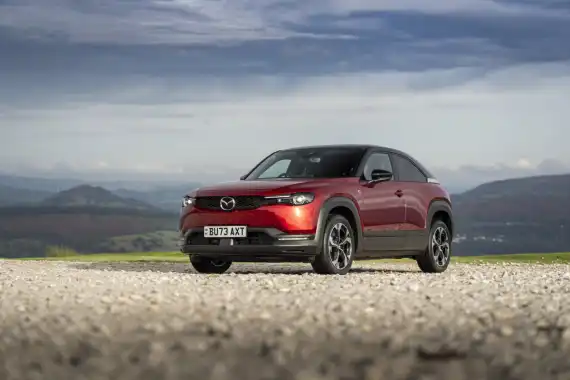
We were really excited when Mazda introduced its MX-30 model back in 2020/21 and it lived up to high expectations apart from a couple of factors, Firstly, the rear suicide doors are just totally unpractical. And secondly, the appalling EV driving range of just 124 miles.
So, when we heard the Japanese carmaker, renowned for doing things its own way, was introducing rotary technology to the vehicle to create a range-extended version with plug-in technology, along with a petrol engine, expectations rose again.
We knew the rear doors would still be an irritant, but wanted to see if that extra reassurance of a petrol engine with a 50-litre tank would add to the car’s appeal. And it certainly has.
Mazda has long been associated with rotary technology with two million cars developed to date since its pioneering Cosmo model in 1967 and the stunning RX-8. And their company’s engineers perfected the set-up to such an extent they became the first Japanese manufacturer to claim a Le Mans victory in 1991 with the rotary-driven Mazda 787B.
But back to present day and the MX-30 R-EV. Customers can choose from trim levels called Prime-Line, Exclusive-Line and Makoto, which we opted for. There was a limited-run Edition R version but those have all been snapped up now.
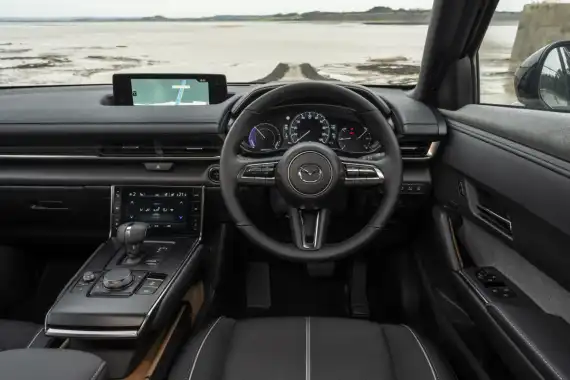
Stand-out design is something that Mazda is famed for and it has to be said the MX-30 certainly has eye-catching appeal with its dynamic good looks.
It’s a five-door model that looks like a sleek two-door sports car thanks to rear suicide doors that are rear hinged and can only be opened if the front doors are opened too. Not practical, but they look pretty cool.
Head-turning features include a gloss black contrast roof and spoiler, black B and C pillars, a black grille housing the Mazda emblem, tinted windows, adaptive LED headlights, signature front LED daytime running lights, a power tilt and slide sunroof and 18-inch black diamond cut alloy wheels.
Move inside and the interior is modern, clutter-free and well thought out with all controls ideally positioned for ease of use on the fly. It’s all very slick with sustainable, yet upmarket upholstery.
The 8.8-inch infotainment screen is controlled via a simplistic, yet practical dial with lots of quick access keys to the many on-board systems. These include Apple CarPlay and Android Auto smartphone connectivity, a pitch perfect 12-speaker Bose surround sound system, navigation including five years of European updates, a rearview camera and plenty more besides.
Below this infotainment screen is a smaller seven-inch touchscreen where all the climate functions are located including the heated seats and heated steering wheel.
The fixtures and fittings are high-end, but the cork finishings in places could divide opinion, although we quite liked it. However, the build quality certainly looks and feels like it will survive the test of time.
On The Road
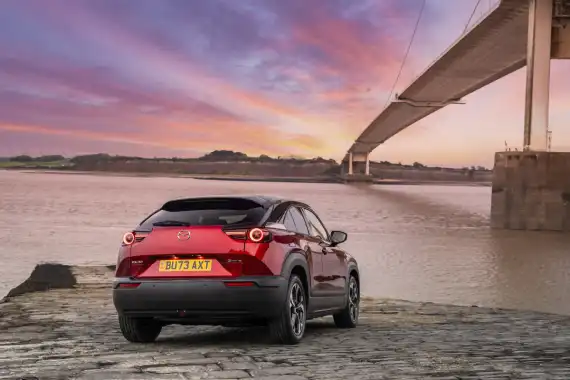
Handling & Performance
So, without getting too technical, the MX-30 R-EV has an 830cc rotary combustion engine beneath the bonnet that acts as a generator and delivers power to the 17.8kWh battery. This in turn drives an electric motor that powers the front wheels for front-wheel drive.
With 170PS and 260Nm of torque, the vehicle can reach 62mph from a standing start in 9.1 seconds (it feels much quicker) and has a top speed of 87mph.
On motorways, the MX-30 R-EV can easily cruise at 70mph and the car is nicely poised and balanced through sweeping country lanes, with minimal signs of body movement in and out of long bends.
The ride is well cushioned and refinement levels are good apart from an occasional whining noise from the powertrain set-up. In busier town centres, the vehicle’s agility impresses and there are steering wheel paddles that can be used to adjust the levels of regenerative braking.
There are three drive modes called Normal, EV and Charge. Provided there is enough battery charge, the car will use electric drive in Normal mode with the rotary engine inactive. If extra power is needed, such as under heavier acceleration, then the rotary engine generator will kick in and supply additional power to the battery.
In EV mode, the car stays in electric mode for as long as the charge lasts, while Charge mode can be selected to safeguard the necessary level of battery charge which may be beneficial if driving in urban areas or to power external devices.
Our range-topping Makoto grade featured a vehicle to load (V2L) power supply which would be great if, for example, you were camping and needed to power a pump to inflate airbeds or run lighting.
On the downside, due to the car’s sleek design, the over the shoulder visibility is poor because of the extra-wide B pillars
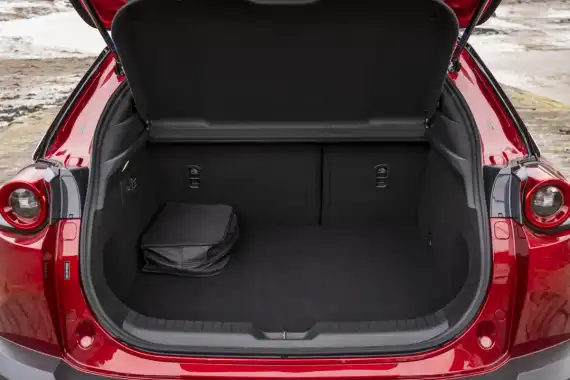
Space & Practicality
The Mazda MX-30 is a neatly styled five-door crossover that looks dynamically designed from any angle. Well, I say five door and that’s an accurate enough statement in a way. That’s because the rear doors open backwards (like suicide doors) and can only be accessed if the front doors are opened first. They are not the most practical to be honest and, with tiny fixed rear windows, anyone sitting in the back will feel quite claustrophobic.
In addition, these rear doors are difficult to open if there is another car parked next to the MX-30 and fitting a child seat is not exactly easy either.
The vehicle stretches 4,395mm in length, is 1,795mm wide (excluding mirrors), 1,555mm tall and has a wheelbase of 2,655mm. With an 11.4-metre turning lock and fairly light steering, it’s agile in busy town centres and the boot can swallow 332 litres of kit, increasing to 1,137 litres with the split-folding rear seats dropped flat.
Elsewhere, there is a glovebox, narrow door bins, a single seat back pocket, central cubby, sunglasses compartment, cup holders and large, practical storage areas between the two front seat occupants.
Charging the MX-30 R-EV’s 17.8kWh battery from 20 to 80 per cent takes 25 minutes using a 50kW DC unit, one hour, 30 minutes if connected to a mode 3 AC port or four hours, 50 minutes via a 2.4kW domestic socket.
Ownership
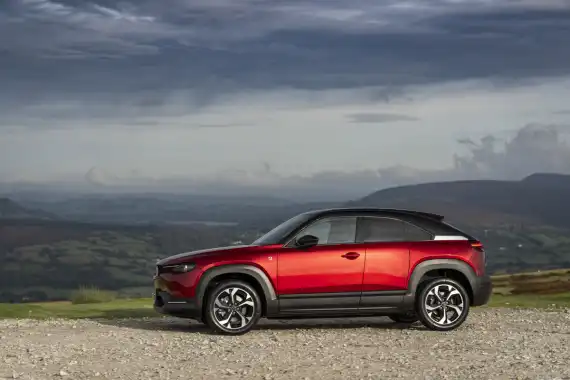
Running Costs
The MX-30 R-EV is available in trim levels called Prime-Line costing £31,250, Exclusive-Line at £33,150 and Makoto, as tested, priced at £36,000. An upgrade to the upholstery on our car added £200 to the cost and the Soul Crystal Red paintwork, along with black side panels and roof, bumped the cost up by a further £1,800.
For business drivers, the MX-30 R-EV has a Benefit in Kind tax rating of eight per cent and the Makoto version sits in insurance group 23.
According to official figures under WLTP testing, the car can deliver a combined 53 electric-only miles which is ample for everyday use and has combined fuel efficiency of 37.2mpg (weighted is 282.5mpg). In fairness to Mazda, we were seeing high forties during our lengthy test drive which is far higher than the given figure. But this drops quite rapidly if covering lots of motorway miles at 70mph.
With 21g/km of carbon emissions, the first-year road tax charge for the car would be £10, increasing to the discounted rate for hybrid models of £170 after 12 months.
The MX-30 R-EV comes with a standard three-year, 60,000-mile warranty which is extended to eight years or 100,000 miles for the battery
Verdict
Sometimes you just have to sit back and admire the creativity of Mazda and its willingness to go its own way – the range-extended MX-30 is the perfect example of this ethos. The all-electric MX-30 was almost eccentrically unique in its design and handling, but had one major drawback and that was its very limited 124-mile range between charges.
So, unlike other manufacturers who would probably have explored larger battery packs, Mazda engineers used their ‘think outside the box’ ingenuity and came up with the idea of revisiting historical technology and adding a new 830cc rotary petrol engine to the mix.
And with that addition, any range anxiety fears are overcome while the car still looks amazing and drives beautifully, which is also the Mazda way.

